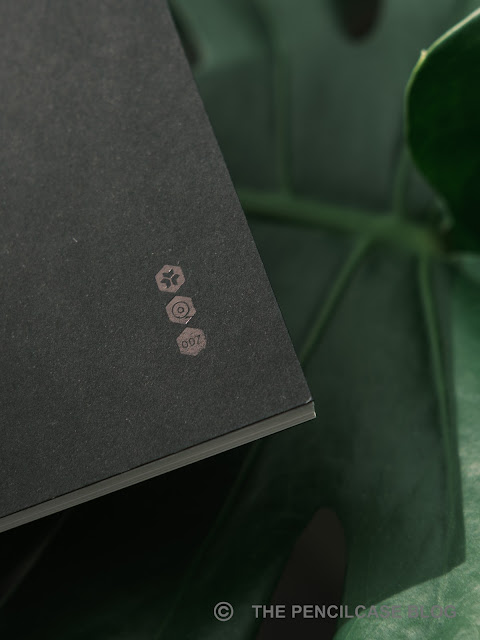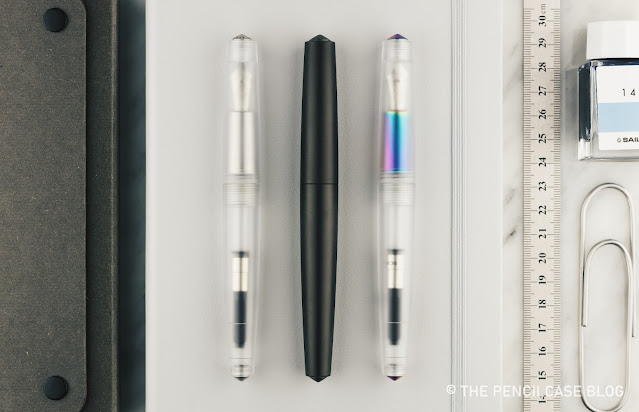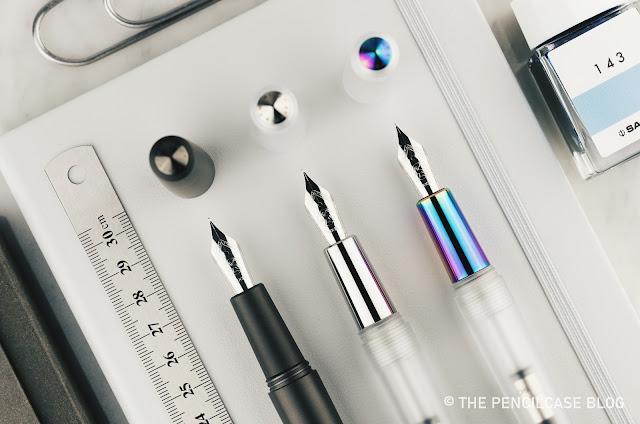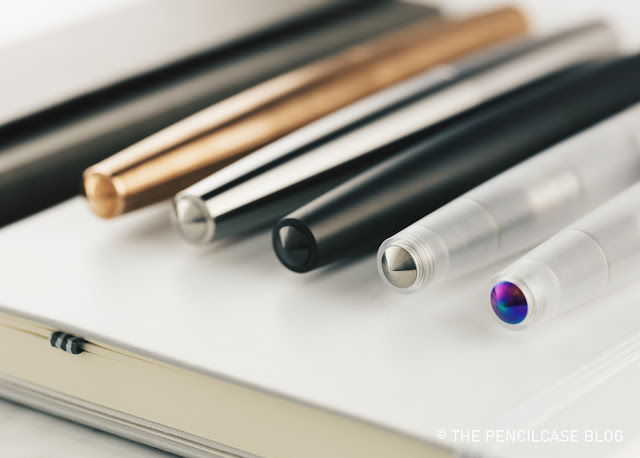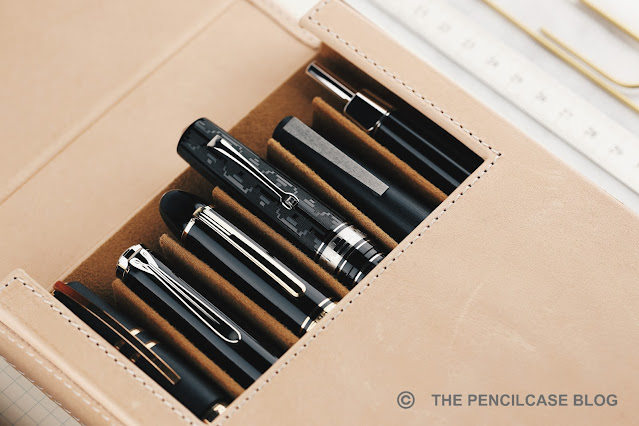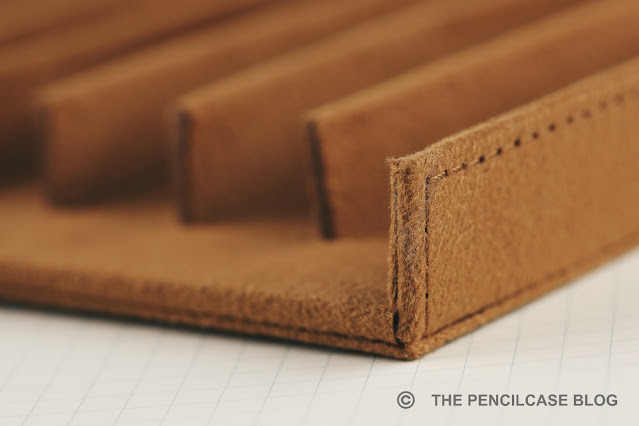Ajoto - the British design brand known for THE pen - has expanded their product catalog with a selection of premium notebooks. Their new "Pocket Paper" notebooks landed on my doorstep a few weeks ago. With the crowdfunding live on Kickstarter as we speak, it's about time to have a quick look at what you can expect from these new products...
The Pocket Paper collection comprises three different notebook types, or rather paper types, accompanied by a custom leather cover and pen holder. All three notebooks share the same external design: softcover (heavy black cardboard stock) with an exposed bound spine that creates an interesting look, but more importantly, a flexible notebook that opens flat without needing too much convincing.
The notebook's lay-flat properties come from the unique Swiss-style binding, a design I've only ever seen on the rather obscure Fantasticpaper Color notebooks (reviewed HERE).
The Swiss binding does have one downside: Because the paper is only attached to the right side of the cover, the left sides of the pages are unsupported and hover in the air a bit. So keep in mind that writing on the reverse side of the pages is a bit awkward. That is, at least until you're past halfway through the notebook.
The Pocket Paper project has apparently been in the works for several years, and I think it shows in the attention to detail of the final product. The packaging is minimalistic and clean, and the notebooks itself reflect the same design style. Minimal branding is visible on the front, just the Ajoto hallmarks stamped in the bottom corner of the cover. The first page has embossed lines (not actually printed) to jot down content details or "return-if-found" information. It's all very tastefully done.
Interestingly, Ajoto chose a very non-standard size for their notebooks. At 17.2 cm tall, and 10.5 cm wide, it's distinctly taller than your average notebook. In fact, it's as wide as an A6, while being as tall as the larger B6 format. For comparison, Midori's large travelers notebook measures 12 by 22 cm.
As they found out in their journey of creating 'the perfect notebook', there's no such thing as one perfect notebook! That's why they're offering three different paper types, to cater to different needs:
 #1 Notebooks come with 116 pages of a rather thick 120 gsm paper. This notebook is pencil/ballpoint/gel pen-oriented, which is clearly noticeable from the coarser paper texture. It can take some fountain pens with finer nibs, but it's not focused on fountain pen use. It's also not the paper to render inks in a particularly nice way, as they mostly fall flat.
#1 Notebooks come with 116 pages of a rather thick 120 gsm paper. This notebook is pencil/ballpoint/gel pen-oriented, which is clearly noticeable from the coarser paper texture. It can take some fountain pens with finer nibs, but it's not focused on fountain pen use. It's also not the paper to render inks in a particularly nice way, as they mostly fall flat. To me, the #1 notebook compares closest to a Leuchtturm or Baron Fig notebook; fountain pens CAN be used, but it's not their main focus. #1 Makes a lot of sense in Ajoto's product lineup since they're focused on making rollerball pens, which pair well with this paper.
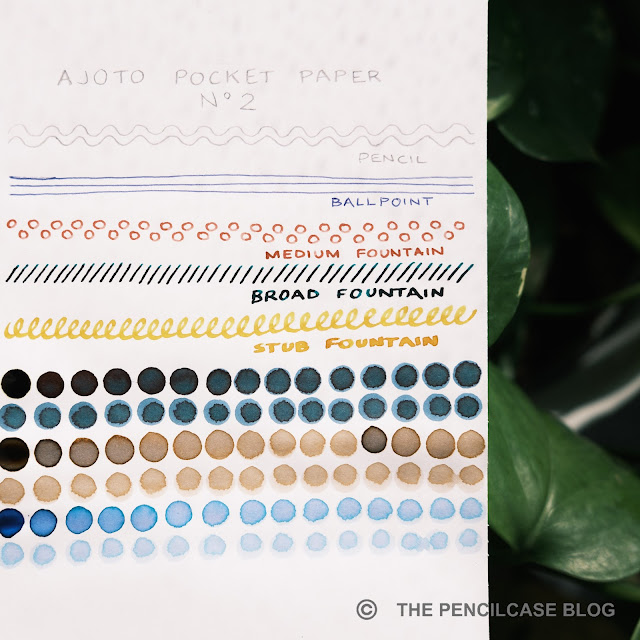
#2 Is a smooth fountain pen-friendly paper. The notebook has 126 pages (slightly more than the #1) of a slightly thinner 100 gsm paper (which is still distinctly heavy for general writing paper). This paper is also noticeably more white than the other two paper stocks (which are a light cream color). #2 can handle a variety of fountain pen nibs and ink swabs like a champ.
 |
| Dry times are longer on the #2 paper, but in return you get excellent shading and sheen characteristics! |
Inks dry nicely with strong, crisp shading and a good amount of sheen. That does come at the drawback of extended drying times, but that's to be expected. There's some showthrough on the back of the page, but no bleedthrough (except with heavy ink swatches).
 Paper #3 is made for sketching and drawing. The notebook contains far fewer pages (only 62) of a much heavier 190g stock. It's quite unconventional paper for a notebook but I can imagine it being a very popular option for (urban) sketching, as it can easily withstand heavy ink and aquarel applications. Fountain pen actually works very well on this paper, too!
Paper #3 is made for sketching and drawing. The notebook contains far fewer pages (only 62) of a much heavier 190g stock. It's quite unconventional paper for a notebook but I can imagine it being a very popular option for (urban) sketching, as it can easily withstand heavy ink and aquarel applications. Fountain pen actually works very well on this paper, too!Ink swatches look great on it, and there's absolutely no bleedthrough whatsoever. Also, the pages don't warp much when using water because the paper is so thick. If you don't mind the lesser page count and want something to experiment with fountain pen inks (maybe a swatch book?), This one could be a very interesting option!
 |
| An overview of the bleedthrough/ghosting you can expect from the different notebooks, from left to right: #1, #2 and #3 |
All in all, I'm very impressed with the overall quality of Ajoto's first steps into the paper world, and I really like their concept with different paper types for different use cases!
I do have two remarks though: For one, I think the heavy card stock covers aren't quite up to the standards I'd expect from a 23€ notebook (MSRP, the pre-order price on Kickstarter is 18€). Something a bit more durable would be nice, especially since these notebooks are designed for pocket carry. Extra durability can be obtained in the form of Ajoto custom leather covers for the Pocket Paper, though at an MSRP of 95.95€, they add a hefty chunk of change to the overall cost.
Secondly, all three paper types are currently only offered in an unruled blank version. Ruled/grid/dot paper options for #1 and #2 will only be made available if certain stretch goals are met during the Kickstarter - I wish they just made those options available straight away. While blank paper absolutely makes sense for the creative-focused #3 paper, #1 and #2 could definitely use a subtle ruling to help structure your writing.
Note: This product was provided by Ajoto, free of charge, so I could write this review. I was in no way influenced in the making of this review. The opinions shared in this review are completely my own! This post does not contain affiliate links.





